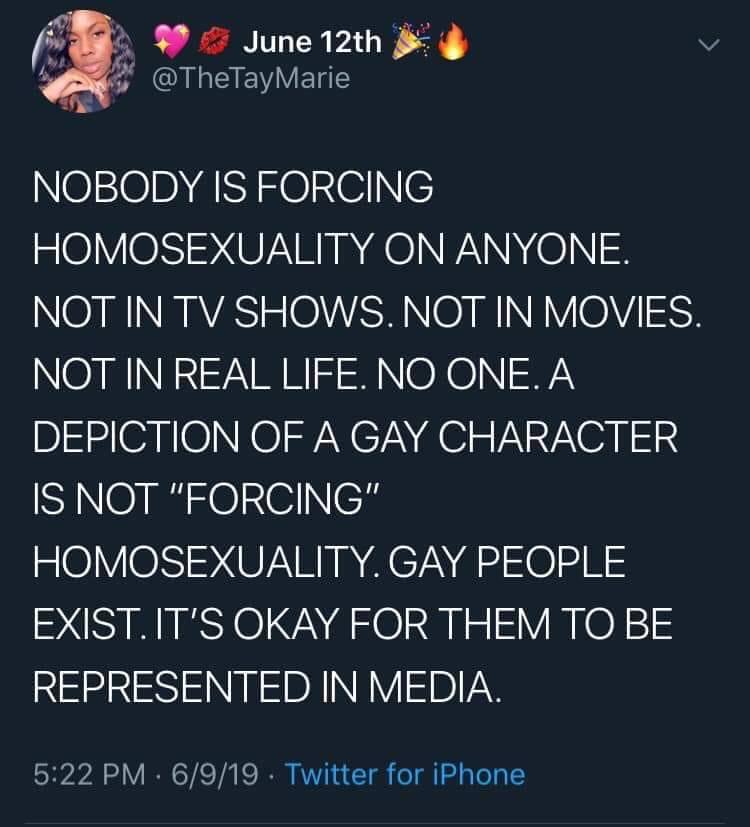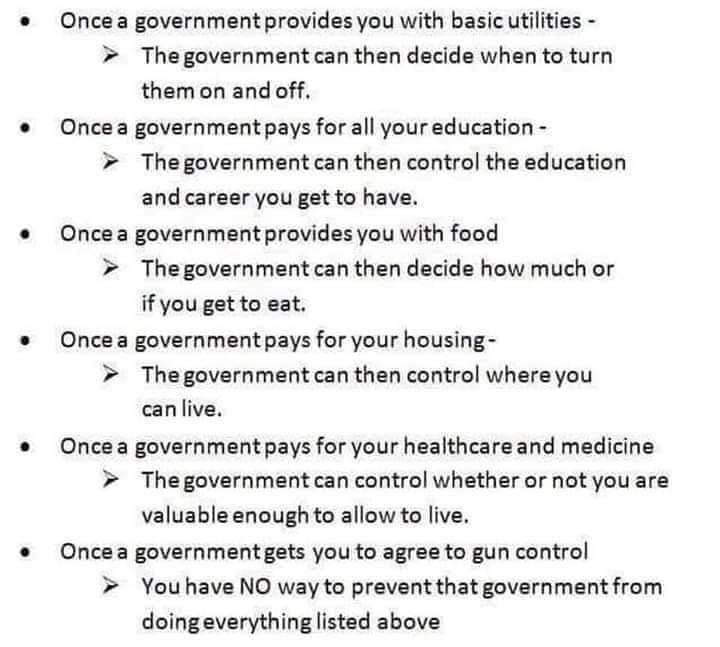
And here’s the original tweet:
And no one is saying it isn’t.
But can we stop acting like gay “representation” in entertainment is something new this decade? And I mean that for everyone.
Will & Grace in it’s initial run from 1998 to 2005 was a rather popular show. Will is a gay man, and so is Jack, one of Will and Grace’s friends. But it wasn’t a show all about Will and Jack being gay and how much they love (or don’t) that they’re gay. It was just one aspect of who they were. They aren’t token gay characters – especially since you can’t really build a multi-season television show around that. They are believable, charming, funny characters for whom being homosexual was just one part of who they were, not the entirety of who they are.
Many other shows as well over the years have had gay characters in one vein or another.
Roseanne had several during its initial run. I believe that show was the first on broadcast television to have recurring gay and bisexual characters: Leon Carp and Nancy Bartlett, respectively. The show was very open about homosexuality and portraying homosexuals as otherwise ordinary people. Imagine that!
The show was the first production to feature a gay wedding in the episode “December Bride“, which aired in 1995, in which Leon marries his fiance Scott (played by Fred Willard), who would become another recurring character on the show with both being good family friends to the Connors. It also showed a rather creative way in which Scott gets some pro revenge on one of Roseanne’s restaurant patrons.
Leon and Roseanne had a contentious relationship at first – Leon was previously Roseanne’s boss – before they eventually become good friends and business partners in Roseanne’s restaurant. Nancy had long been one of Roseanne’s best friends.
The Practice ran from 1997 to 2004 with a diverse recurring cast, and an even more diverse guest lineup across its eight (8) seasons. John Larroquette played Joey Heric, a character who appeared several times in the show’s lineup. His lovers also had a rather… interestingly alarming tendency to end up dead. Heric was also gay. He was a deranged psychopath who delighted in manipulating the legal system to get away with murder. But he was also gay.
It is possible to have a compelling narrative around gay characters merely for those characters being gay. The Simpsons managed to do just that with the episode called “Homer’s Phobia” in 1997. And the Roseanne episode “Don’t Ask, Don’t Tell” from 1994 also accomplished this. But those were also singular episodes, though, not entire series runs.
What about movies? Aside from movies that happened to have gay characters – Gypsy 83 starring Sara Rue comes to mind (kind of a niche film) – were there any movies centered around gay characters merely for them being gay? And by that, I don’t mean film festival movies, but movies starring A-list celebs? Absolutely.
Readily coming to mind is a movie from 1997. Yes, 1997. Kevin Kline starred as Howard Brackett in In & Out. (See it at Amazon Prime, YouTube) Howard was engaged to Emily (played by Joan Cusack), ready to be married, until his life and his town were turned upside down when he was “outed” at the Oscars on national television by Cameron Drake, a celebrity actor from their town. Drake had just won the Oscar for Best Actor for portraying a gay man in the US Army who is dishonorably discharged for that (this was before DADT). And as part of his “thank you speech”, he mentioned Howard and declared him to be gay.
Eventually Howard comes to realize he is gay and comes to terms with his sexuality, coming out at the altar of all places, after being “helped” along by Peter Malloy, a reporter who is also gay played by Tom Selleck. Howard also loses his job due to coming out. Upon learning that at graduation, when they’re surprised Howard isn’t named “Teacher of the Year”, the student body and local community come together in protest to support Howard.
Remember that movie was made in 1997. It’s a very good movie and I highly recommend it. I remember sneaking out to see it as well during high school. I forget what I told my dad I actually intended to do, but he handed me $10 and I went to see it at the local theater in small town Iowa. And everyone in the theater found the movie absolutely hilarious as well. No one as far as I could tell took any issue with the movie being centered around a gay man. No one took issue with Kline’s gay kiss with Tom Selleck.
So, in all seriousness, can we stop acting like gay “representation” in entertainment only started this decade?
* * * * *
Now one can say all they want that an author shouldn’t need a reason to make a character gay, black, trans, or pink with purple polka-dots that change color when rain approaches. And they would be right. What’s needed, though, is a relevant and compelling narrative reason to bring up their sexuality at all. See the aforementioned examples above.
In other words a character being gay or another minority isn’t a story unto itself. We need a compelling narrative around or about the character.
One ready example is Miles Morales, a black-Latino Spider-Man featured in Spider-Man: Into the Spider-Verse, which saw great box-office success. Morales also isn’t just a “black Spider-Man”, Peter Parker with darker skin but otherwise nothing new to offer. He’s a fleshed-out character in his own right. Unfortunately we likely won’t have Miles Morales in a live-action MCU movie anytime soon, though I’m hoping the sequel to Far From Home brings him in.
Speaking of Spider-Man, though, the new MJ – Michele Jones – is also not a biracial version of the previous MJ – Mary Jane Watson. She’s a new character in her own right with her own narrative.
Also from Marvel is Big Hero 6, which features a diverse cast of teenagers working as a team, each with their own personalities and quirks. The Pixar film based on the comics also saw great box-office success.
And no mention of Marvel would be complete without mentioning Nick Fury, since it plays into the new controversy regarding Ariel in the upcoming live-action The Little Mermaid. The original Nick Fury was white. In the Ultimate Marvel universe, he’s heavily adapted after Samuel L. Jackson. Likely the reason that adaptation of Fury was adopted in the MCU. But SLJ’s version of Nick Fury isn’t just a carbon copy of the original Fury with black skin. He’s a new, compelling character. And, arguably, a lot more bad-ass than the original. Because it’s Samuel L. Jackson, so why would he NOT be?
But let’s get back to homosexuality and making characters gay just so one can claim a movie or television show has a gay character.
“How to Get Away with Murder” is another show with a diverse recurring and very diverse guest cast. And recurring character Connor Walsh is gay. Very, very overtly so, actually. But he isn’t just a “token gay character”, a character that exists just to say there’s a gay character. Unlike previously-mentioned characters, his sexuality is actually a very important part of his narrative. As in several instances he cleverly uses it to his advantage, taking advantage of a couple other gay men to get what he needs. And breaking up Michelle’s engagement as well. (Oops!)
Again, though, it seems a lot of people are insisting on making characters gay or what have you for literally no reason except “representation”. Even with characters whose sexuality bears no relevance to the narrative.
Which brings me to Albus Dumbledore. Why did Rowling never mention in the books that he’s gay? It isn’t relevant. Just as it wouldn’t be relevant if Rowling wanted to declare McGonagall to be bisexual. Or say that any of Ron Weasley’s brothers are gay or bi or transsexual. Hermione and Ginny could’ve been a thing at one point for all we know. But almost all of those details would more distract from the narrative than add to it.
Which is what makes Hikaru Sulu’s sexuality in Star Trek Beyond a little nerve-wracking. It was put there merely because George Takei publicly stated he’s gay. No, seriously, that’s the only reason that happened. So they just presumed that Sulu must be gay as well merely because George Takei is gay. But it’s an otherwise irrelevant detail. And there is also no narrative indicator of it throughout the entirety of the original series, including the original movies, hence the backlash to it being included.
This would be like Sara Gilbert trying to assert Darlene Connor as a lesbian in the aforementioned Roseanne merely due to Gilbert being a lesbian. Except that would be worse since it would run counter to the established storyline rather than there being no narrative reason to believe it.
At least David Hyde Pierce hasn’t tried asserting his character of Niles Crane on Frasier as gay. If he were to try, he’d face a significant backlash as such would run counter to everything in the entire 11 seasons of the show. Including one episode where Niles overtly says he is not gay, declining the advances of a gay ski instructor. Indeed his entire run as the character shows how brilliant an actor he can be, as corroborated by being nominated for a Primetime Emmy for Best Supporting Actor every year he played the character. And winning 4 times.
Worst still than that with Frasier would be if Dan Butler tried to retroactively declare his character “Bulldog” Brisco to be gay merely because Butler is gay. Again, it would run completely counter to the character, as anyone who’s familiar with the show would readily say.
And Frasier had its share of gay characters as well through its 11 season run. I’ve already mentioned the gay ski instructor. There was also Lilith’s husband, Brian, who ran off with another man, so she sleeps with Niles to reassert her femininity. But also look for the episode that guest-starred Patrick Stewart. And there was also another episode in which Frasier questions his sexuality following a series of gay erotic dreams.
* * * * *
“But, representation!”
Here’s the thing about writing fiction in general: don’t show what is not relevant. Meaning don’t show a person getting romantically involved with another character unless and until it’s relevant to the narrative.
I think what really has the “representation!” crowd’s panties in a bunch is presumption. That if the reader is not told or outright shown a character is gay, they fear the audience will presume the character is straight. Seriously?
Let me ask this: did anyone really presume that Sherlock Holmes was straight? The original character, not the adaptation portrayed by Robert Downey, Jr.
“But what about Irene Adler?” one may ask in protest, trying to assert that Adler shows that Holmes is straight. Not quite. Here is Watson’s description of Holmes and his fascination with Adler in “A Scandal in Bohemia”:
To Sherlock Holmes she is always the woman. I have seldom heard him mention her under any other name. In his eyes she eclipses and predominates the whole of her sex. It was not that he felt any emotion akin to love for Irene Adler. All emotions, and that one particularly, were abhorrent to his cold, precise but admirably balanced mind. He was, I take it, the most perfect reasoning and observing machine that the world has seen, but as a lover he would have placed himself in a false position. He never spoke of the softer passions, save with a gibe and a sneer. They were admirable things for the observer — excellent for drawing the veil from men’s motives and actions. But for the trained reasoner to admit such intrusions into his own delicate and finely adjusted temperament was to introduce a distracting factor which might throw a doubt upon all his mental results.
Adler is the only woman to outsmart him. Holmes readily presumes most people he encounters to be intellectually inferior to him. He undoubtedly thought such of Adler. Yet she managed to outsmart him, outwit him. For that he has forever respected her. His fascination with her was never romantic, but always intellectual. She was the woman.
To take their connection and assert that Holmes is undoubtedly heterosexual requires reading well beyond what is evident in the storyline. Indeed Watson’s description of Holmes places him, if he must be labeled, as asexual. He also rarely shows really any emotion, believing it to inhibit his reasoning ability.
And there are numerous other characters for whom we can say their sexuality is largely irrelevant and for which there is also no narrative indicator in any direction. Palpatine comes to mind. He lusts only for power. Most of the Jedi neuter or spay themselves with the Force (and some probably literally so) so who knows what kind of mixed bag existed there. The same with most of the officers in the various Star Trek renditions. This includes Hikaru Sulu.
In all the above cases, their sexuality largely didn’t matter since it doesn’t serve any particular narrative. If someone wants to presume those characters are all straight, gay, or bisexual, that’s their prerogative. But there isn’t anything in the narrative they can use to support such a presumption.
Again, the pushback isn’t about having gay or lesbian characters since, again, there have been plenty over the years that have been very well-received by audiences. I’ve already demonstrated plenty of examples above. The pushback is about having a gay or lesbian character without any substance, or making a character gay or lesbian overtly for no narrative reason. Or taking an established character and making that character gay or bisexual either for no narrative reason or in contradiction to all established narrative.
Yes we know that homosexuals exist. And homosexuals have been portrayed in television and other media for the last several decades, if not longer, without issue. There are and have been many well-received gay and lesbian characters over the years.
It is in recent years, however, where people seem to think this is only a recent phenomenon.
At the same time, if “representation” really concerns you, make new, compelling characters who are also homo or bisexual rather than insisting on changing or “rebooting” established characters with the sexuality or other minority status of your choice.
 For nearly the last 4 years, I’ve been a consistent regular patron at Fazoli’s, specifically the location off Shawnee Mission and Quivira in the Kansas City metro. Going with that, I’ve participated in the Fazoli’s reward program since they introduced it in 2017.
For nearly the last 4 years, I’ve been a consistent regular patron at Fazoli’s, specifically the location off Shawnee Mission and Quivira in the Kansas City metro. Going with that, I’ve participated in the Fazoli’s reward program since they introduced it in 2017.

You must be logged in to post a comment.